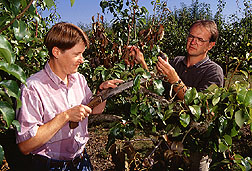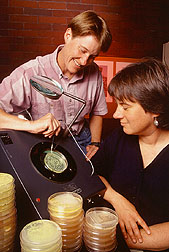Fire Blight Control, Nature's Way
|
|
Apples and pears are big business for both large and small fruit growers in the Pacific Northwest. Washington, Oregon, and California produce more than 6 million tons of the two fruits annually, worth more than $2 billion.
Research by Agricultural Research Service and university scientists is helping the growers manage one of the industry's major disease challenges, fire blight. In addition to the standard chemical controls, growers are beginning to have access to another tool: biological control.
The bacterium Erwinia amylovora causes the blight. Wind, rain, and insects carry the bacteria to fruit blossoms. Warm, wet weather helps the bacteria reproduce. Once a large population builds up, the bacteria can infect the blossom and spread internally through the stem. Fire blight isn't a problem every year, but when it does flare up, growers can spend thousands of dollars removing infected tree limbs.
In the 1950's, the antibiotic streptomycin became the treatment of choice. Copper and other chemicals joined the arsenal later.
But the favored streptomycin began losing its effectiveness in the 1970's because E. amylovora was showing resistance—at least in California.
In 1988, ARS plant pathologists Joyce E. Loper and Rodney G. Roberts spearheaded an effort that showed streptomycin resistance was taking hold in Washington. Since then, ARS plant pathologist Virginia O. Stockwell has found streptomycin resistance in Oregon.
"Unfortunately, streptomycin sprays for fire blight control are less reliable than in the past," Stockwell says. She and Loper work at the Horticultural Crops Research Laboratory in Corvallis, Oregon. Roberts is at the Tree Fruit Research Laboratory in Wenatchee, Washington.
To help growers manage the streptomycin resistance, the ARS scientists intensified their work—and helped with university research already under way—on biological control options.
The first commercial biological control product went on the market in 1995 after years of testing. Blight Ban, produced by Plant Health Technologies of Boise, Idaho, uses a beneficial bacterium, Pseudomonas fluorescens Pf-A506. This strain of Pseudomonas competes with the fire blight organism for nutrients on blossoms, keeping the numbers of Erwinia low enough to avoid severe infection. The key is to give the biocontrol organisms a head start so they can build up a large population before the pathogen arrives.
Steven E. Lindow, plant pathologist at the University of California-Berkeley, discovered Pf-A506 in 1979 as beneficial for reducing fire blight and frost damage. To confirm its effectiveness, ARS scientists contributed 5 years of testing to Lindow's 16 years. Working with Oregon State University plant pathologist Kenneth Johnson, Stockwell and Loper also found that Pf-A506 maintains optimum effectiveness if freeze-dried.
Another important finding: The biocontrol can be used safely with antibiotics—but not with copper, which is also used for fire blight control. Now they're testing Pf-A506 in combination with other biocontrol organisms, such as E. herbicola C9-2. Although this bacterium is related to the pathogen that causes fire blight, it is a different species and does not hurt the fruit trees. In fact, C9-2 produces antibiotics that inhibit the growth of E. amylovora. Plant Health Technologies hopes to use C9-2, once registration with the U.S. Environmental Protection Agency is complete.
More Biocontrols on the Way
A new technique developed by ARS plant pathologist Larry Pusey in Wenatchee is speeding up the search for effective biocontrols. The technique allows efficient, year-round screening for naturally occurring organisms with the potential to suppress E. amylovora.
Pusey's method uses crab apple nursery stock. These trees are cheap and readily available because they are used by growers to help pollinate apple orchards.
Pusey gets the small trees from nurseries in December or January. He uses some and holds others dormant until needed. By stripping leaves off trees that have already provided blossoms and adding a growth hormone, he can induce individual trees to bloom twice in 12 months. Currently, he gets new stock every year, but he thinks he can manipulate the trees to provide blooms twice a year for 2 or 3 years before new ones are needed.
Pusey developed a laboratory assay that uses live blossoms plucked from greenhouse trees to test for effectiveness of an organism in controlling fire blight. He is now in a position to pre-screen thousands of new organisms and conduct in-depth studies with those that are especially promising. Previously, researchers had to assess the value of potential biocontrols by growing them on sliced pear fruit, which is very different from the flower tissue the slices are meant to represent.
|
|
"Our lab results closely mirror what happens in actual field studies, or what would happen assuming that field studies could be done. Fire blight is not a problem every year. If the right weather conditions aren't present, we can't successfully field-test new organisms," says Pusey.
Pusey has one natural bacterial strain that seems very promising. He has applied for a patent and private industry has shown interest in further testing.
Consistently Inconsistent
Because biological controls are living organisms, they don't always perform consistently over a wide range of conditions. Loper and Stockwell in Corvallis are trying to resolve that problem at a genetic level.
"Variability is a huge obstacle to using biocontrol in agriculture," Loper says. "The goal of our work is to identify sources of variability so that we can use biocontrol organisms more effectively."
When sprayed on trees, Pf-A506 often establishes well on pear or apple blossoms. But it sometimes dies off rapidly and does not persist long enough to suppress the fire blight pathogen. On the plant surface, bacteria face drying out (desiccation) and temperature changes, Loper says. Her goal is to manipulate beneficial bacteria genetically to help them thrive under adverse conditions.
In Pseudomonas fluorescens Pf-5, a strain related to the active bacterial agent in Blight Ban, Loper identified a gene called rpoS that governs how bacteria respond to environmental stresses like desiccation. Stockwell and Loper are now doing field tests to see if rpoS influences the capacity of Pf-A506 to survive on blossoms or to suppress fire blight.
ARS' commitment to fire blight control doesn't stop at the orchard fence. Plant pathologist Roberts has worked for the last 11 years on international plant quarantine issues related to fire blight. The West Coast fruit industry depends heavily on exports to maintain profitability and good domestic prices, but the presence of fire blight in the United States has limited development of new markets in Asia, Europe, and Australia.
Roberts' work showed that commercially produced apples from Washington do not pose a significant risk of carrying the fire blight pathogen to countries where fire blight does not occur. Roberts also led a team that confirmed the effectiveness of a postharvest chlorine treatment now used for all apples exported to Japan.
Similar research with pears done collaboratively by Roberts and Pusey kept open the Brazilian export market—currently valued at $35 million annually—and might allow future exports to Chile, should U.S. growers attempt to develop a pear market there.—By Kathryn Barry Stelljes and Dennis Senft (retired). To reach the authors, contact Marcia Wood, Agricultural Research Service Information Staff, 800 Buchanan St., Albany, CA 94710; phone (510) 559-6070.
Joyce E. Loper and Virginia O. Stockwell are at the USDA-ARS Horti cultural Crops Research Laboratory, 3420 N.W. Orchard Ave., Corvallis, OR 97330; phone (541) 750-8760, fax (541) 750-8764.
Larry Pusey and Rodney G. Roberts are at the USDA-ARS Tree Fruit Research Laboratory, 1104 North Western Ave., Wenatchee, WA 98801; phone (509) 664-2280, fax (509) 664-2287.
"Fire Blight Control, Nature's Way " was published in the January 1998 issue of Agricultural Research magazine. Click here to see this issue's table of contents.








